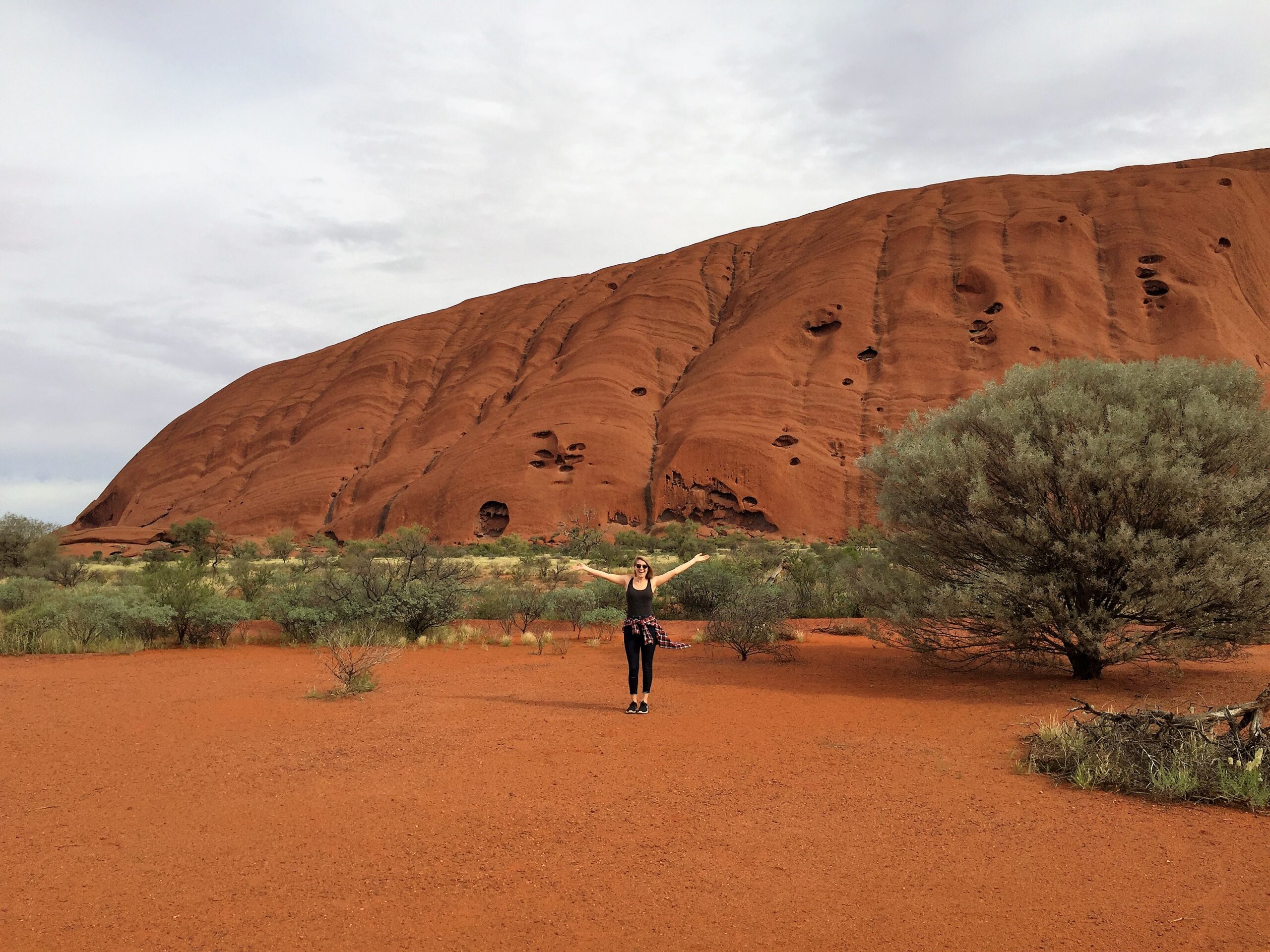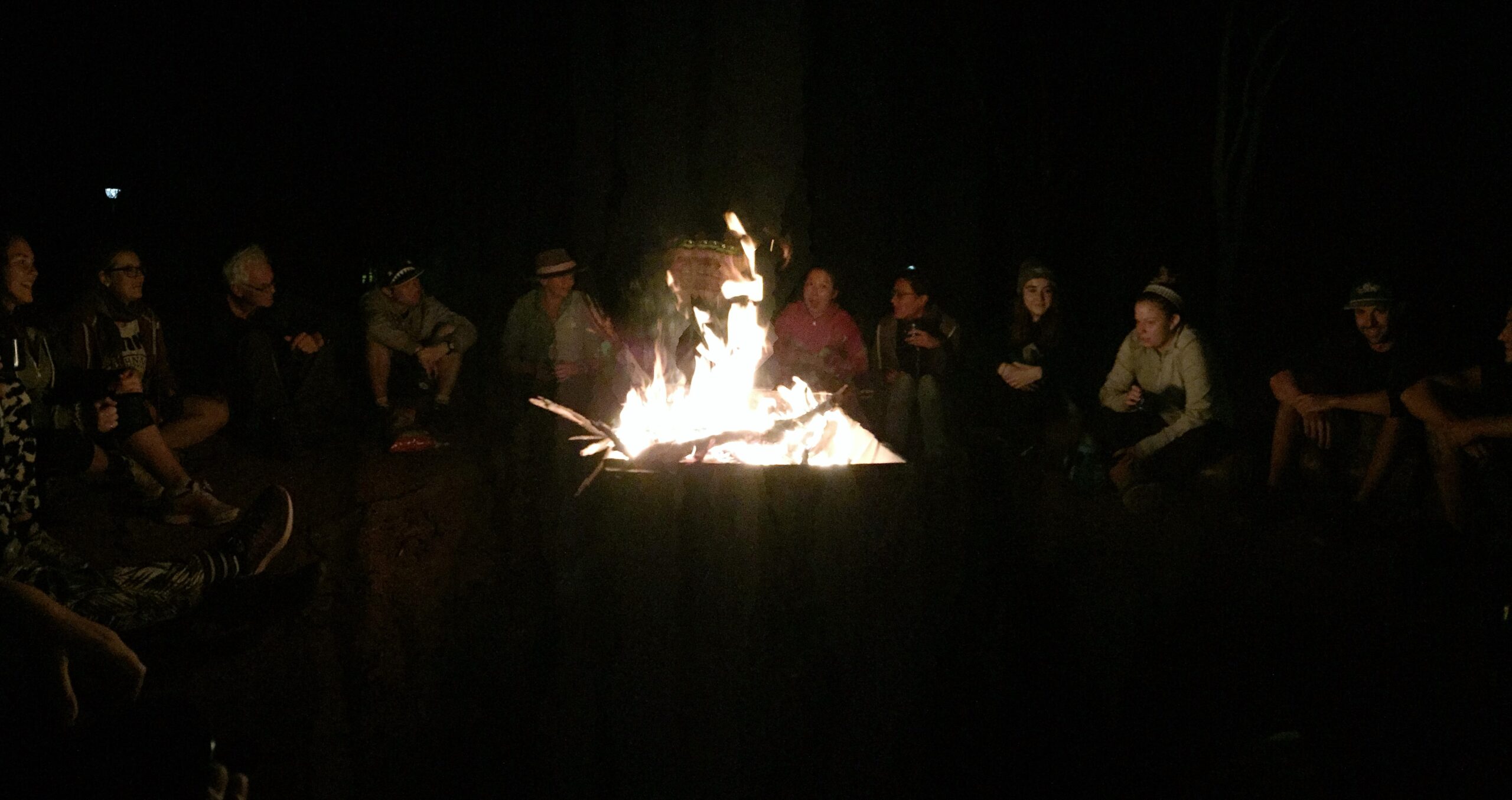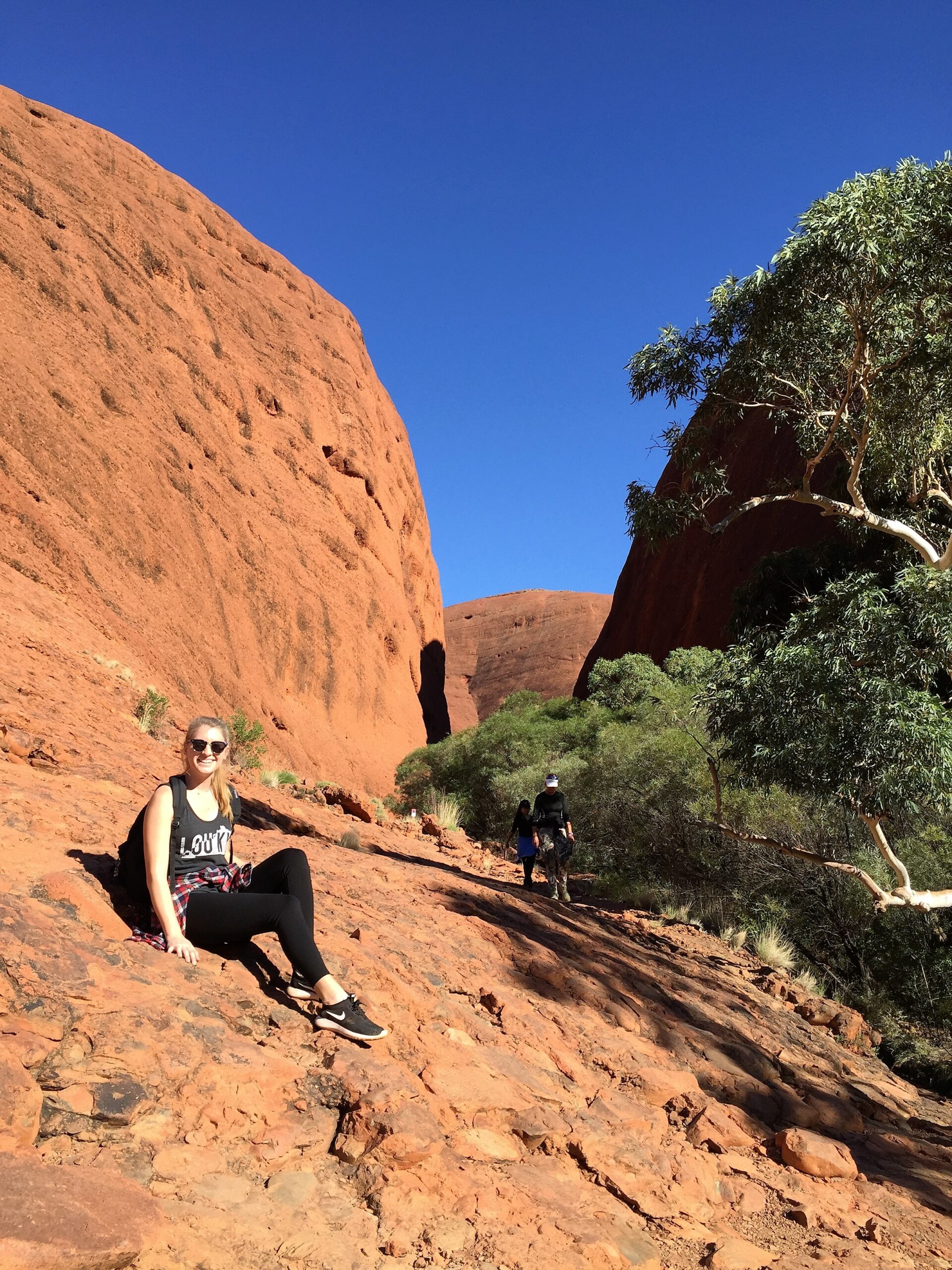Uluru, Kata Tjuta, and Kings Canyon – The Three Wonders of the Australian Outback
My Experience with The Rock Tour
3 Day/2 Night Alice Springs to Alice Springs
When one thinks of Australia, there are a few things that usually come to mind: The Sydney Opera House, the Great Barrier Reef, and the Outback. Now, I have seen the Opera House, I have seen the Great Barrier Reef, but what I had not seen was the Outback. I had not yet experienced the true bush land of central Australia. I had not stepped foot on the red desert. And there is one landmark that sticks out to most when they think of Outback Australia: Uluru.
I first heard of Uluru when reading my Nat Geo travel book; thinking to myself, “I have to go there.” What is Uluru? Uluru is essentially a giant red rock in the middle of nowhere, Australia. At least, that’s what my impression of the rock was before I actually saw it and learned about it.
What’s so special about a giant rock? I asked myself. Well, I wanted to find out what the buzz was all about. So I booked my flight to Alice Springs and set off on a 3-day and 2-night camping tour with The Rock Tour. What I didn’t know was that when I got picked up at 5:25am on Friday the 20th of May, was that I was about to experience one of the most incredible weekends of my life.
DAY 1 - ULURU
I stayed the night at the YHA in Alice Springs the night before the tour. Like most tours, pick up times vary depending on where you’re staying. Ashleigh (our tour guide, bus driver, chef, and photographer for the weekend), picked me up at 5:25am. An early start to the day, but so worth it!

We had a full tour of 21 people, and after everyone was together on the bus, we set off toward Uluru, our destination for Day 1.
Uluru-Kata Tjuta National Park is actually quite a drive away from Alice Springs, but we were able to sleep in the bus along the way, occasionally gazing out the window at the first of many spectacular sunrises in the Outback. There is something so revitalizing about knowing you are in the middle of nowhere.
We stopped a few times along the way for coffee and toilet breaks, and we also stopped to collect firewood for the campfire as we got closer to the campsite. As we wandered around in search for good firewood, Ashleigh so eloquently reminded us that we were in the desert, “if the stick is moving, it’s not a stick”. Fortunately, no moving sticks were found this time!

When we finally got close enough to the National Park that we could see Uluru, the whole bus lit up. There it is! I thought. There’s that massive rock I have been looking forward to seeing for months. And even from afar, it was magnificent. All that was running through my mind at that moment was, “I can’t believe I am actually here at Uluru!” And it was true – seeing something so unique and extraordinary was genuinely hard to believe.
We arrived at our campsite – Yulara Resort Campground – for the evening around noon, where we dropped off the firewood, our overnight bags, and had some sandwiches for lunch. Finally, we were headed to the Cultural Center to learn about the Aboriginal significance of Uluru, the cultural history of the rock, and why we don’t climb it.
Walking through the cultural center was very enlightening. I learned about the Anangu people, who were the traditional owners of Uluru, and the story of how and why it became a sacred landmark for these Aboriginal people. As I read more about the Anangu people and their beliefs, I felt worse and worse about calling it “some big red rock”. It clearly was not.
When the “white people” came in and discovered Uluru and the Aboriginals that occupied the area, the land and the people were treated with so much disrespect that it made me uncomfortable and sad. Travelers and tours would come in and climb the rock like it was theirs to conquer, completely disregarding any sacred beliefs of the Anangu.
Eventually, the “white people” (Australians) were able to join together with the Aboriginals in a board of directors for the National Park. This board protects both the natural beauty of the rock and establishes and enforces rules for visitors to ensure that Uluru remains a sacred landmark. The rules are very simple: don’t climb the rock, don’t take photos or videos in sacred areas, and respect the land.
Although I was anxious to see Uluru and walk the base walk, I was very happy that we visited the Cultural Center first. This way, when I did get to see Uluru up close, I could appreciate it with that much more respect. Would it be cool to climb it? Sure! But after learning the history of Uluru, I didn’t feel the need to climb it. Just admiring it from the ground was all I needed to take it in.
At last, we left the Cultural Center and headed for the start of the base walk. The walk took about 1.5 – 2 hours, and I found out after that we walked about 6 km. Which is actually insane to think that 6 km walking was only covering the circumference of about three-fourths of the rock. Just to give you an idea in relativity about how big the rock actually is.



Walking around the base of Uluru was incredible. You don’t realize from the photos just how geographically intricate the surface is. And of course, as you’re looking at it, you remind yourself that this is one solid rock and you try to fathom how that is even possible. Uluru definitely served as a (not so subtle) reminder that our Earth is capable of producing some mind-blowing things.




We met Ashleigh close to the watering hole at Uluru for a culture and art talk, as there are some rock Aboriginal rock paintings that we were able to see. It was very interesting to see how Aboriginal people told stories through art.


Next up was the sunset and dinner. We drove over to the location where you can see the best sunsets at Uluru, and prepared for the multitude of photos. Meanwhile, Ashleigh prepared our (delicious) dinner, of pasta, rice, veggies, and chicken.

After sunset, we headed to the campsite to get the campfire going. But of course, having Ashleigh as our tour guide meant we had to make quite the impression on the rest of the campsite, so we blasted “We are the Champions” by Queen as we rolled in, the last ones to arrive. Ashleigh quickly proved to have the best road trip playlist I have ever heard in my life.
The campsite was equipped with indoor plumbing and showers and was very clean. We set up our swags around the campfire and roasted marshmallows and played some campfire games. In case you were like me and had no idea what a swag was, it is basically a rolling mattress and cover for your sleeping bag. We didn’t have tents, we slept in the open air around the campfire and I wouldn’t have it any other way. Sleeping under the stars in the middle of the outback was epic.

DAY 2 – ULURU SUNRISE & KATA TJUTA
On Day 2, Ashleigh woke us up to peaceful music at 5:15 am. We had 30 minutes to use the toilet and pack up camp to get on the bus to catch the sunrise at Uluru.
Ashleigh set up our breakfast so we could eat while we were waiting for the sun to come up. We had hot tea and coffee, toast with jam, cereal, and yogurt. It was a bit cloudy that morning, and we were worried that we weren’t going to get to see a good sunrise. But remarkably, the clouds actually worked in our favor.
As the sun was rising (and of course Ashleigh started playing “The Circle of Life” from the Lion King for dramatic effect), the sky looked as if it was painted with water colors, filled with radiant shades of yellow, orange, pink, and purple. I have never seen a sunrise this spectacular in my entire life. And the fact that it was shining over Uluru just made it that much better. It was absolutely breathtaking. Photos cannot do it justice. I’ll just have to rely on my own memories for this one.


(Ashleigh channeling her inner Lion King at Uluru)
After the sunrise, we had to say goodbye to Uluru, as we were off to our next destination: Kata Tjuta. Kata Tjuta is another solid rock formation, but instead of just one rock, it has many rocks, as its Aboriginal name suggests.

We set forth on the Valley of the Winds walk, which was about 3 hours in total. This hike was fantastic, as you walked through several of the rock domes for amazing views from different angles.


Ashleigh gave us another talk about the geology of both Uluru and Kata Tjuta, explaining how scientists believe they came to be. She also explained that Kata Tjuta is Aboriginal “man’s land”, meaning only men can come here. There are certain domes of Kata Tjuta that no one other than Aboriginal men have even seen before, because they are sacred, hidden, and can only be seen from a location that we are not allowed to set foot on. I found this fascinating, as there is still so much about Aboriginal culture that we have yet to learn, if we ever will.

About halfway through, we walked up a steep dome in between two larger domes, so it kind of felt like we were sitting in the middle of a canyon. Definitely worth the steep incline!


When we completed the hike, we headed back to camp for lunch, which were make-yourself wraps with tons of options for fillings. It was time to leave the national park and make our way toward King’s Canyon. It was about a 4 hour drive to our campsite, but we were so exhausted from the hikes the past 2 days that we all had a nice nap along the way.
We also stopped along the way to get more firewood, and some beers and ciders for the campfire that night.
The second campsite location was at King’s Creek, still equipped with indoor plumbing and showers. This location certainly felt more remote than the first, but in a good way. The only problem we experienced at this campsite were dingoes, which are apparently there most nights. Just be sure to lock up your bags in the bus and don’t leave your shoes out, and all will be fine! The dingoes are more interested in your snacks than you.
Once we started the campfire, Ashleigh cooked us an amazing dinner on the campfire! She baked homemade bread, and made a few pots of meat, veggies, and rice to mix together. It was delicious, and we enjoyed it with our beers and ciders by the fire. The perfect end to day 2.

DAY 3 – KINGS CANYON
Day 3 was the earliest wake up of all – but it was beyond worth it. Ashleigh woke us up at 4:30 am, and we had an hour to go to the toilet, pack our things, and eat breakfast before heading off to King’s Canyon. We arrived early enough to actually hike the first bit of it (about an hour) to the top so we could watch the sunrise from the top of the canyon.
The sunrise at Uluru was hard to top, but this came in close second! As the sun rose up, it lit up the red rocks of the canyon perfectly, and the view was out of this world. We were literally standing on the top of a canyon as the sun was coming up. I have never hiked in the dark before, but it was an amazing experience. Not many can say that they have done that.


After we admired the sunrise, we continued the rest of the hike through Kings Canyon. The rest of the hike was about 2 more hours. We saw the watering hole at the base of the canyon, which has never been empty. This was so bizarre to me, thinking that we are in the middle of the desert, but there was this strange tropical oasis in the bottom of the canyon with a constant source of water.

Ashleigh also taught us about a few of the plants and trees that thrive in the canyon.

Kings Canyon was probably my favorite hike of the three. It was a really beautiful place, along with Uluru and Kata Tjuta. I was sad to be leaving these three wonderful places, but we had explored everything I wanted to and more by the end of the Kings Canyon hike.


We then started our journey back toward Alice Springs, stopping along the way to make lunch, which was wraps and leftovers from dinner the night before. We also stopped at a camel farm, where you could ride a racing camel for only $7! Yes, racing camels are a thing, and it is apparently a very popular sport in the outback.

Our last stop of the tour was to take an obligatory group photo in front of the “Welcome to Alice Springs” sign as we made our way back into civilization.

Even though we were dropped off at our accommodation in Alice Springs, the tour wasn’t over just yet. We had plans to go to the Rock Bar in town together as a tour group to have dinner and drinks and say goodbye to everyone. We had an incredible three days together, and I couldn’t imagine seeing the Australian Outback with any other tour guide (shout out to Ashleigh – you were awesome, and I want your playlist!) or any other random bunch of people.
A huge thank you to the Rock Tour for putting together an amazing 3-day and 2-night camping tour. I will remember this weekend forever!
If you would like to book your camping adventure with the Rock Tour, please visit this link for the Alice Springs to Alice Springs return trip:
There are also other options for start and end locations, visit www.backpackerdeals.com to book the best tour for you!
Author’s note: If you would like to read more written by me, you can visit my personal blog at: https://arielearoundtheworld.wordpress.com/









